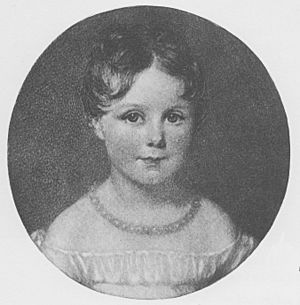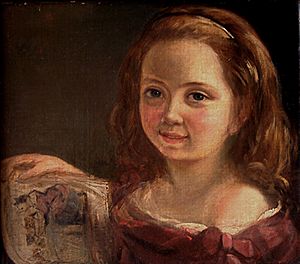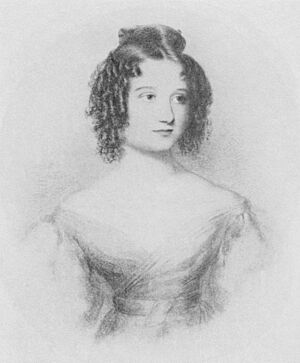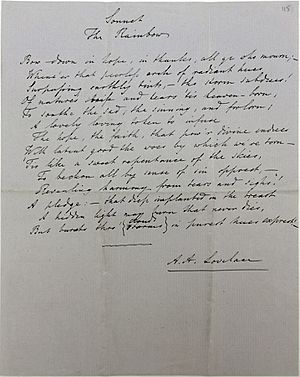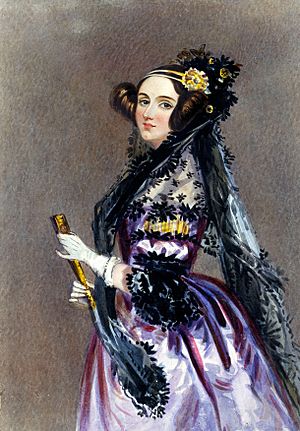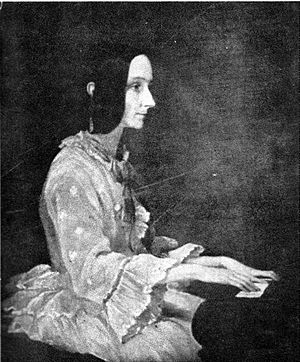Ada Lovelace facts for kids
Quick facts for kids
The Countess of Lovelace
|
|
|---|---|
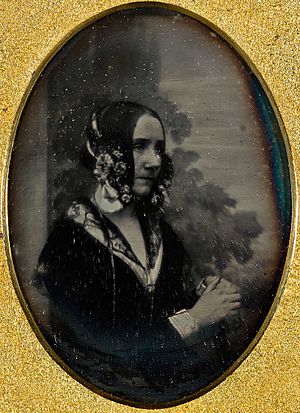
Daguerreotype by Antoine Claudet (c. 1843). One of only two known photographs.
|
|
| Born |
The Hon. Augusta Ada Byron
10 December 1815 London, England
|
| Died | 27 November 1852 (aged 36) Marylebone, London, England
|
| Resting place | Church of St. Mary Magdalene, Hucknall, Nottingham, England |
| Known for | Mathematics, computing |
| Spouse(s) | |
| Children |
|
| Parent(s) |
|
| Signature | |
Augusta Ada King, Countess of Lovelace, born Ada Byron (December 10, 1815 – November 27, 1852), was a brilliant English mathematician and writer. She is often called the world's first computer programmer.
Ada Lovelace was the only child of the famous poet Lord Byron and his wife, Anne Isabella Milbanke. Her father had hoped for a boy. He left England forever just a month after Ada was born. He passed away in Greece when she was only eight years old.
Contents
Ada's Early Life and Learning
Ada Lovelace was often sick when she was young. At age eight, she had bad headaches that made it hard for her to see. In 1829, she became paralyzed after getting measles. She had to stay in bed for almost a year.
By 1831, she could walk again using crutches. Even with these illnesses, Ada became very good at math and technology.
Her Education
Ada's amazing math skills started to show when she was 17, in 1832. Math became a huge part of her adult life. She was taught at home by private teachers. These included William Frend, William King, and Mary Somerville. Mary Somerville was a well-known scientist and writer in the 1800s.
Later, in the 1840s, a mathematician named Augustus De Morgan helped her a lot with her math studies. She even learned advanced calculus, which is a very complex type of math.
Ada's Amazing Work
Ada Lovelace was always very interested in new scientific ideas. After working with Charles Babbage, she kept exploring other projects. In 1844, she told a friend she wanted to create a math model. This model would explain how the brain creates thoughts and how nerves create feelings. She called it "a calculus of the nervous system," but she never finished it.
Meeting Charles Babbage
Ada first met Charles Babbage in June 1833. They were introduced by their friend Mary Somerville. Later that month, Babbage invited Ada to see his new machine, the difference engine. She was fascinated by it. She used her friendship with Mary to visit Babbage as often as she could.
Babbage was very impressed by Ada's intelligence and how well she could analyze things. He even called her "The Enchantress of Number."

The First Computer Program
From 1842 to 1843, Ada spent nine months translating an article. It was written by an Italian mathematician, Luigi Menabrea. The article was about Babbage's newest machine, the Analytical Engine. Ada added her own notes to the article.
Explaining the Analytical Engine was very hard. Many other scientists didn't understand it. People in Britain also didn't show much interest. Ada's notes even had to explain how the Analytical Engine was different from Babbage's first machine. Her work was well-received at the time.
Ada's notes were about three times longer than the original article. They were labeled with letters from A to G. In note G, she described a step-by-step process, called an algorithm. This algorithm would allow the Analytical Engine to calculate special numbers called Bernoulli numbers.
Today, the Analytical Engine is seen as an early model for a computer. Ada's notes are considered a description of a computer and its software. Because of this work, many people believe Ada Lovelace was the first computer programmer. Her method is often called the world's first computer program. However, the Analytical Engine was never fully built, so her program was never tested.
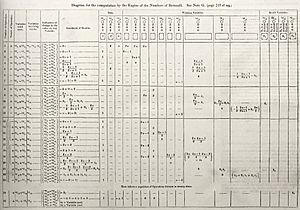
Ada's Personal Life
On July 8, 1835, Ada married William, 8th Baron King. She then became Lady King. They had three homes: one in Surrey, one in Scotland, and a house in London. From 1845, their main home was Horsley Towers. This large house was designed by the same architect who built the Houses of Parliament. Ada herself helped design some of the later additions to the house.
Ada and William had three children:
- Byron (born 1836)
- Anne Isabella (born 1837)
- Ralph Gordon (born 1839)
Ada's Final Years
Ada Lovelace passed away at the age of 36 on November 27, 1852, from cancer. She asked to be buried next to her father. They are both buried at the Church of St Mary Magdalene, Hucknall in Nottinghamshire, England. A special plaque in Latin honors her and her father.
Remembering Ada Lovelace
Ada Lovelace's contributions to computing are remembered in many ways:
- In 1981, the Association for Women in Computing created the Ada Lovelace Award.
- Since 1998, the British Computer Society (BCS) has given out the Lovelace Medal. They also started a yearly competition for women students in 2008.
- BCSWomen supports the Lovelace Colloquium, which is a yearly meeting for women university students.
- Ada College in London is a college focused on digital skills, named after her.
Ada Lovelace Day
Ada Lovelace Day is an annual event held on the second Tuesday of October. It started in 2009. Its goal is to "raise the profile of women in science, technology, engineering, and maths." It also aims to "create new role models for girls and women" in these fields. Events on this day often include improving articles about women on Wikipedia.
Other Tributes
- The Ada Initiative was a group that worked to get more women involved in open-source software.
- The computer science building at University of Zaragoza is called the Ada Byron Building.
- A computer center in the village of Porlock, where Ada lived, is named after her.
- Ada Lovelace House is a building in Kirkby-in-Ashfield, near where she grew up.
- In 2013, Ada Developers Academy was founded and named after her. It helps women and diverse people become software developers.
- Since 2015, new British passports include an illustration of Lovelace and Babbage.
- In 2018, a small satellite was launched and named in honor of Ada Lovelace.
- In 2018, the United States Senate declared October 9, 2018, as National Ada Lovelace Day.
- In 2020, Trinity College Dublin commissioned a bust of Lovelace, one of the first women to be honored this way in their library.
- In March 2022, a statue of Ada Lovelace was put up in London. It was unveiled on International Women's Day.
- In September 2022, Nvidia announced a new computer chip design called Ada Lovelace.
Bicentenary Celebrations
The 200th anniversary of Ada Lovelace's birth was celebrated with many events, including:
- Lectures on "Computability" at the Israel Institute for Advanced Studies.
- A symposium at the University of Oxford.
- Ada.Ada.Ada, a one-woman show about her life, which travels internationally to promote diversity in STEM.
Special exhibits were also held at the Science Museum, London and the Weston Library in Oxford.
Interesting Facts About Ada Lovelace
- Ada was named after her father's half-sister, Augusta Leigh. Her father, Lord Byron, called her "Ada."
- She didn't see a family portrait of her father until her 20th birthday.
- Ada was taught math from a young age because her mother thought it would stop her from becoming like Lord Byron, who her mother thought was "insane."
- Lovelace often combined poetry and science to question basic ideas.
- She believed that imagination and intuition were very important for using math and science well.
- Ada valued metaphysics (the study of reality) as much as math. She saw both as ways to explore "the unseen worlds around us."
- Lovelace didn't think machines could truly "think" on their own. She wrote that the Analytical Engine "has no pretensions whatever to originate anything. It can do whatever we know how to order it to perform."
- The computer language Ada, created for the United States Department of Defense, was named after Lovelace.
See Also
 In Spanish: Ada Lovelace para niños
In Spanish: Ada Lovelace para niños


